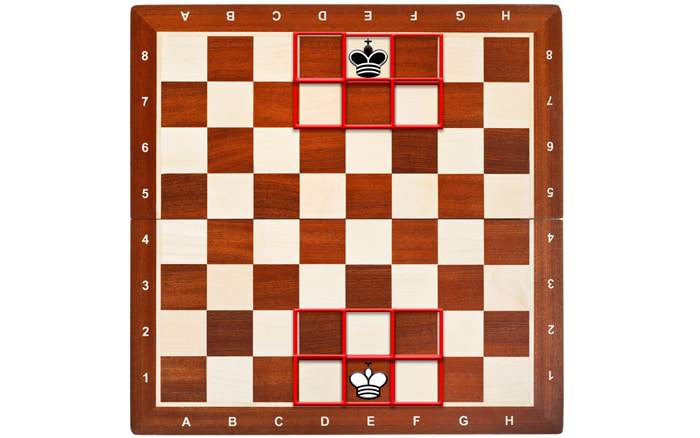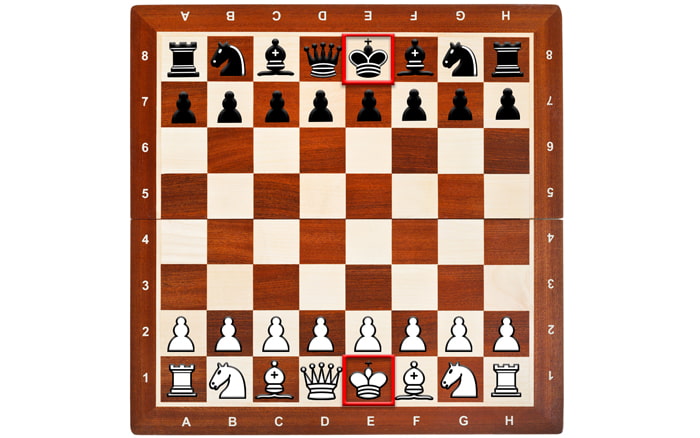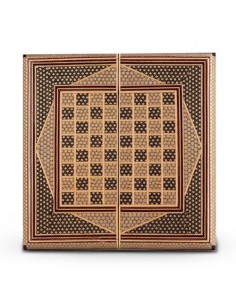- R.A
- information
- 10324 views
- 2 comments
The King is the most important piece in the chess game, embodying both strength and vulnerability. King movement in chess is critical to learn. Do You know what is the King's movement in chess? How many squares can a king move in chess? Or can king move 2 steps in chess?
Its movement is characterized by limited range, and Whether the King moves forward, backward, or sideways, he can only move one square. Additionally, the King has a unique and special move known as castling.
It is impossible for the King to move into a dangerous position. A king's downfall would mean that your opponent has won the battle, since the game's goal is to trap the King. Distinguishing features, such as the cross atop the King's crown, make him easy to recognize. In addition to being the tallest piece on the board, the King also holds the most significant influence.

Placement of King in Chess
Before learning How to play Chess, First, you must know how to place the chess pieces on the board. So knowing the placement of a king in chess is basic and very essential. The white chess king placement is in the queen's right house, and the black King is at the end of the page in front of the white King. According to the signs of the chess game, the white King is placed in the e1 square, and the black King is placed in the e8 house, as shown in the picture below:
Cyrus Crafts; Luxury & Unique Products

How Many Spaces Can a King Move in Chess?
In each chess king moves, It can move diagonally, That means the king is able to move one house in all directions (width, length, and diameter). Due to its importance and vulnerability, the King usually could be more active in the early and mid-game, but it can be a strong and effective piece at the end of the game.

In the figure below, the King cannot move because his path is blocked by pawns, knights, and other pieces. First, pawns or knights must move to clear the King's path.

For example, in the picture below, the King is in house f3 and can go to the eight squares next to him, which are marked with red color, but if the same King is in house b1, the number of houses he can go to is five squares, and if he is in house h8 He could only go to three houses.

Top Chess King Moves in the Endgame
There are few chances for the King to be a hero. His safety is always his priority. More often than not, he hides behind his pawns like a coward, with nowhere to go but behind his pawns. How embarrassing. A game's endgame changes all that. The danger of checkmate is reduced when fewer pieces are on the chessboard. The King is like any other piece in that it can come out of its rabbit hole to fight.
The best chess players in the world care more about the safety of their king and do not allow their opponent to attack their king as much as possible.
Can a King Take the Own Pieces?
You may wonder, can the King bypass the same color piece, or does he have to take all pieces? The King cannot jump over other pieces or only capture his own pieces.

In the example above, the King is in the f3 square, but this time he can only go to four houses because pieces of the same color occupy the other houses. In chess, we cannot take our own pieces and remove them from the game.
Capturing with the King
The king in chess can take the opponent's pieces as he moves.

In the example above, the king can take the opponent's rook and the above image changes to the below image. We remove the black bishop from the game and place our king in its place.

Castling (Special King Move)
During casting, the Rook and the King are moved for the king's protection and can only be done once per game. These special rules of chess apply to the king and the rook. By casting, you can accomplish two key tasks:
- Get your king to safety
- Move your rook out of the corner and into the middle of the game.
By moving the king two squares to one side, you can shift the rook right next to the king on the opposite side. A castle can only be constructed if the following conditions are met:
- It can be only the first move for the rook
- It can be only the first move for the king
- The path between the king and rook must be clear (no pieces can block them)
- The king cannot be under “check,” or must not have passed one
Now, can you tell how does the king move in chess?

You will find that the king will get closer to the chessboard if you castle in one direction. This is called a “king side castling.” No matter which side you castle to, the king will move only two squares when castling. A queen side castling is when you castle your king behind a wall of pawns on the other side of the board, where the queen sits.
Chess King : Check and Mate
Checking the King means that he is under attack from an enemy piece. A King cannot stay on or move to a square where an enemy piece can capture him.
There are 3 pathways to get out of check:
- move the king out of check
- block the check with another piece
- capture the piece putting the king in check.
Checkmate occurs when a king is in check, and none of these options are legal. In this case, the game is over. As the Persian word Shah Mata implies, "The King is dead." This is the meaning of the word checkmate. This is why handicraft chess backgammon sets have great value and beauty worldwide, especially in the USA and Canada.

Short Ranged King
As with knights, kings are short-ranged pieces. To demonstrate his strength, he needs to be developed. As long as he's seated at the back, he cannot help us much. Activating our King and moving it off the back rank is one of the first things we should do in an endgame. Your King should be more active when fewer enemy pieces are on the board.
Rule: If there are only pawns on the board, you should move your King to the center of the board to support your passed pawns, attack enemy pawns, and block access to crucial squares for the enemy king.
King Vs King (Opposition & Outflanking)
It is not uncommon for one King to march in and capture some pawns at the end of a pawn endgame. Sometimes, a King can do this despite the other King trying to keep him out. Despite the obstacles, he finds a way to get through. There are two standard methods used by Kings when they fight each other:
- Opposition
- Outflanking

The opposition occurs if the Kings stand on the same line with one empty square between them. If the other King has to move, you have opposition. It is possible to control the situation when there is opposition. You have the right to move when the other King moves. To see who is stronger is like a quest for dominance. Your King can advance if your enemy retreats. If he moves to the side, then you have a choice:
- Go around him (outflank)
- Stop him from advancing (keep the opposition)
Isn't it amazing?

Chess King Moves Review
Chess is one of the best and most creative intellectual games in the world, full of ups and downs, and has many fans. Chess has captivated many philosophers, artists, scientists, etc. People like Frederic the Great, Napoleon Bonaparte, Mendeleev, Charles Dickens, and Tolstoy.
If you are also interested in strategic games that require intelligence and accuracy, you can visit the Backgammon setup page to feel the charm of this game more. By the way, please share your thoughts about the king move in chess.
If you are a professional chess player or lover and want to have a unique chessboard of your own, you can shop for one-of-a-kind handmade chess sets from CyrusCrafts. We offer handicrafts and other items at the best prices with a worldwide delivery. You only need to fill out your desired product's order form and wait for us to deliver it right to your address.

















Comments (2)